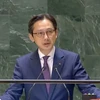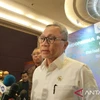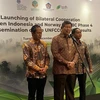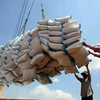The Association of Southeast Asian Nations (ASEAN) will continue to grow in the fast lane, an outperformer with upside potential, said Standard Chartered Bank.
Edward Lee Wee Kok, the bank’s regional head of research for Southeast Asia, said ASEAN has consistently outperformed global growth and grew two percentage points faster than the average global growth from 1980-2013.
With an ASEAN Economic Community scheduled to be in place in 2015, intra-ASEAN trade is set to benefit from this, Lee said at the Standard Chartered's Global Research Briefing 2015 in Kuala Lumpur on January 12.
Standard Chartered's special report on ASEAN revealed that intra-ASEAN trade has more than tripled since 2000 to 295 billion USD in 2013 -- a compound annual growth rate (CAGR) of 9.3 percent.
The region has a combined gross domestic product (GDP) of 2.4 trillion USD, making it the world's eighth-largest economy, it said.
The report showed potential for this trade corridor to grow further as ASEAN economies continue to register economic growth.
Factors driving this growth include greater ASEAN economic integration, rising wealth, economic development, urbanisation, improving infrastructure and rising productivity, according to the report.
On foreign direct investment (FDI), ASEAN attracted nine percent of global FDI in 2013, more than China, and has grown at a CAGR of 15 percent since 2005.
China's loss of cost competitiveness is incentivising a shift in investment from China into ASEAN, it said.
Investors are attracted to ASEAN's cost-efficient labour supply, improving infrastructure, trade pacts, supportive investment environment, regional stability, rising wealth and rapid economic growth, it added.
Lee also highlighted that as of 2013 only about 46 percent of the ASEAN population was urban.
Urbanisation can be a strong growth driver. ASEAN's urbanisation can boost infrastructure development, as the region is still relatively rural, he said.
Lee also cited the bank’s report, saying that ASEAN's GDP per capita may more than double to 8,500 USD in 2030 from 3,900 USD in 2013, based on recent urbanisation trends.
On population, he said ASEAN's population was set to rise by more than 10 percent to 690 million by 2020, and its labour force was expected to grow by 70 million by 2030.-VNA
Edward Lee Wee Kok, the bank’s regional head of research for Southeast Asia, said ASEAN has consistently outperformed global growth and grew two percentage points faster than the average global growth from 1980-2013.
With an ASEAN Economic Community scheduled to be in place in 2015, intra-ASEAN trade is set to benefit from this, Lee said at the Standard Chartered's Global Research Briefing 2015 in Kuala Lumpur on January 12.
Standard Chartered's special report on ASEAN revealed that intra-ASEAN trade has more than tripled since 2000 to 295 billion USD in 2013 -- a compound annual growth rate (CAGR) of 9.3 percent.
The region has a combined gross domestic product (GDP) of 2.4 trillion USD, making it the world's eighth-largest economy, it said.
The report showed potential for this trade corridor to grow further as ASEAN economies continue to register economic growth.
Factors driving this growth include greater ASEAN economic integration, rising wealth, economic development, urbanisation, improving infrastructure and rising productivity, according to the report.
On foreign direct investment (FDI), ASEAN attracted nine percent of global FDI in 2013, more than China, and has grown at a CAGR of 15 percent since 2005.
China's loss of cost competitiveness is incentivising a shift in investment from China into ASEAN, it said.
Investors are attracted to ASEAN's cost-efficient labour supply, improving infrastructure, trade pacts, supportive investment environment, regional stability, rising wealth and rapid economic growth, it added.
Lee also highlighted that as of 2013 only about 46 percent of the ASEAN population was urban.
Urbanisation can be a strong growth driver. ASEAN's urbanisation can boost infrastructure development, as the region is still relatively rural, he said.
Lee also cited the bank’s report, saying that ASEAN's GDP per capita may more than double to 8,500 USD in 2030 from 3,900 USD in 2013, based on recent urbanisation trends.
On population, he said ASEAN's population was set to rise by more than 10 percent to 690 million by 2020, and its labour force was expected to grow by 70 million by 2030.-VNA



















